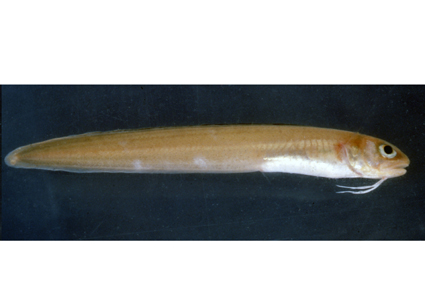Abstract
A cusk-eel, known from the Galápagos Archipelago since 1905, which has remained undescribed, is herein formally named, Ophidion galapagensis Lea & Robins. The species is known from 10 collections, including material from Isla del Coco. The species is endemic to the Galápagos Archipelago–Isla del Cocos biogeographic complex and is compared to the seven known eastern Pacific ophidiine cusk-eels; its relationship to these species is unclear. It is distinguished by dorsal-fin ray, anal-fin ray, and vertebral counts, and the relationship of pelvic-fin filaments and pectoral-fin length. It is most frequently collected by ichthyocide from depths between 3–25 m and taken by bottom trawl to depths of 110 m. It is occasionally observed by scuba divers during night dives.
References
- Breder, C.M., Jr. (1936) Scientific results of the second oceanographic expedition of the “Pawnee” 1926. Heterostomata to Pediculati from Panama to Lower California. Bulletin of the Bingham Oceanographic Collection, 2 (3), 1–56.
- Constant, P. (1992) Marine Life of the Galapagos. A Guide to the Fishes, Whales, Dolphins, Other Marine Animals. Calao Life Experience, Paris, 248 pp.
- Constant, P. (2007) Marine Life of the Galápagos: The Diver’s Guide to Fishes, Whales, Dolphins, and Marine Invertebrates, Second Edition. Odyssey Books & Guides, New York, New York, 307 pp.
- Gilbert, C.H. (1890) Scientific results of explorations by the U.S. Fish Commission steamer Albatross. No. XII.—A preliminary report on the fishes collected by the steamer Albatross on the Pacific coast of North America during the year 1889, with descriptions of twelve new genera and ninety-two new species. Proceedings of the United States National Museum, 13 (797), 49–126. https://doi.org/10.5479/si.00963801.13-797.49
- Girard, C.F. (1858) Fishes. In: General report upon zoology of the several Pacific railroad routes. Reports of explorations and surveys, to ascertain the most practicable and economical route for a railroad from the Mississippi River to the Pacific Ocean. U.S. Senate Executive Document, No. 78, 33rd Congress, 2nd Session, 10 (4), pp. i–xiv + 1–400. https://doi.org/10.5962/bhl.title.146979
- Grove, J.S. & Lavenberg, R.J. (1997) The Fishes of the Galápagos Islands. Stanford University Press, Stanford, California, 863 pp.
- Grove, J.S., Long, D.J., Robertson, D.R. & Victor, B.C. (2022) List of fishes of the Galapagos Archipelago, Ecuador. Journal of the Ocean Science Foundation, 39, 14–22. https://doi.org/10.5281/zenodo.7065587
- Grove, J.S., Massay, S. & García, S. (1984) Peces de Islas Galápagos, Ecuador. Instituto Nacional de Pesca, Guayaquil, Ecuador. Boletin Científico y Tecnico, 7 (2), 1–157.
- Hildebrand, S.F. & Barton, O. (1949) A collection of fishes from Talara, Perú. Smithsonian Miscellaneous Collections, 111 (10), 1–36. https://doi.org/10.5962/bhl.part.9028
- Hubbs, C.L. (1916) Notes on the marine fishes of California. University of California Publications in Zoology, 16 (13), 153–169.
- Humann, P. (1993) Reef Fish Identification Galápagos. New World Publications Inc., Jacksonville, Florida, 192 pp., index.
- Jordan, D.S. & Bollman, C.H. (1890) Scientific results of explorations by the U.S. Fish Commission Steamer Albatross. No. IV.—Descriptions of new species of fishes collected at the Galapagos Islands and along the coast of the United States of Colombia, 1887–’88. Proceedings of the United States National Museum, 12 (770), 149–183. https://doi.org/10.5479/si.00963801.12-770.149
- Lea, R.N. (1997) A new and unique ophidiine cusk-eel from the Panamic region of the eastern North Pacific. Bulletin of Marine Science, 60 (3), 960–965.
- Lea, R.N. & Béarez, P. (1999) Occurrence of Chilara taylori (Ophidiidae), an eastern North Pacific cusk-eel from Ecuadorian waters. Cybium, 23 (1), 99–100.
- Lea, R.N., Frable, B.W. & Robertson, D.R. (2023) Misidentification of Ophidion imitator Lea, 1997 as Otophidium indefatigabile Jordan & Bollman, 1890 (Ophidiiformes: Ophidiidae: Ophidiinae). Zootaxa, 5230 (1), 95–96. https://doi.org/10.11646/zootaxa.5230.1.7
- McCosker, J.E. & Rosenblatt, R.H. (2010) The fishes of the Galápagos archipelago: An update. Proceedings of the California Academy of Sciences, Series 4, 61 Supplement II (11), 167–195.
- Miller, E.C. (2023) Historical biogeography supports Point Conception as the site of turnover between temperate East Pacific ichthyofaunas. PLoS ONE, 18 (9), e0291776. https://doi.org/10.1371/journal.pone.0291776
- Robins, C.R. (1962) Studies on fishes of the family Ophidiidae—VII. The Pacific species of Lepophidium. Copeia, 1962 (3), 487–498. https://doi.org/10.2307/1441170
- Robins, C.R., Robins, R.H. & Brown, M.E. (2012) A revision of Lepophidium (Teleostei, Ophidiidae), with the description of eight new species. Bulletin of the Florida Museum of Natural History, 52 (1), 1–94. https://doi.org/10.58782/flmnh.uuks3039
- Rosenblatt, R.H. & Walker, B.W. (1963) The marine shore-fishes of the Galápagos Islands. Occasional Papers of the California Academy of Sciences, 44, 97–106.
- Sabaj, M.H. (2020) Codes for natural history collections in ichthyology and herpetology. Copeia, 108 (3), 593–669. https://doi.org/10.1643/ASIHCODONS2020
- Snodgrass, R.E. & Heller, E. (1905) Papers from the Hopkins-Stanford Galapagos Expedition, 1898–1899. XVII. Shore fishes of the Revillagigedo, Clipperton, Cocos and Galapagos Islands. Proceedings of the Washington Academy of Sciences, 6, 333–427.


